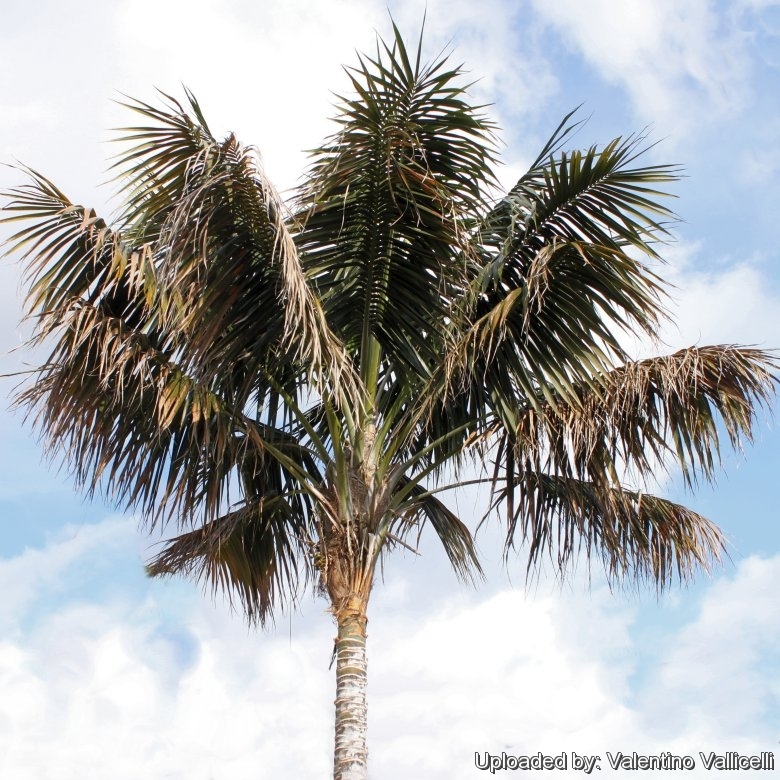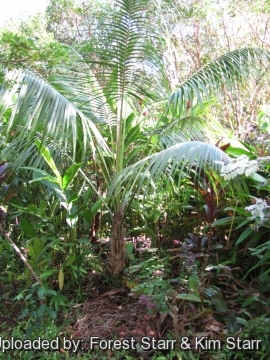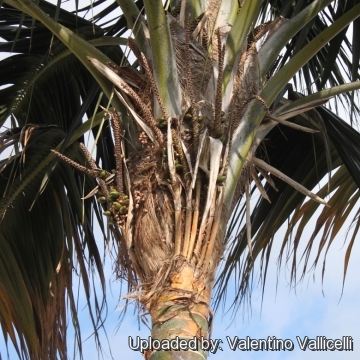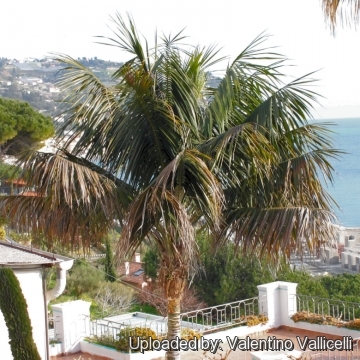Accepted Scientific Name: Howea forsteriana (F.Muell.) Becc.
Malesia 1: 66. 1877

Crown, at Bordighera, Liguria, Italy.
Origin and Habitat: Endemic to Lord Howe Island group, in the Tasman sea about 804 km off the eastern coast of New South Wales, Australia. It is also extensivley grown on Norfolk Island. It is used widely indoors and out as ornamental around the world. Probably it is the most widely used and most popular "house plant" of all time, dating back to the 1850s.
Habitat: It is the predominant element of the sub tropical forest of the island, up to about 400 metres of altitude. The climate on Lord Howe Island is subtropical, warm to cool.
ow in extensive colonies at low to moderate altitudes, less than 2870 ft (875 m) above sea level.
Synonyms:
Common Names include:
ENGLISH: Parlor palm, Hotel palm, Thatch palm, Thatch-leaf palm, Sentry palm, Paradise palm, Kentia palm, Forster sentry palm
CATALAN (Català): Quèntia
DUTCH (Nederlands): Kentiapalm
ESTONIAN (Eesti): Forsteri kentiapalm
FRENCH (Français): Kentia
GERMAN (Deutsch): Forstersche Kentia, Kentiapalme
ITALIAN (Italiano): Kentia, Howea
JAPANESE (日本語): Kencha yashi
RUSSIAN (Русский): Ховея Форстера
SPANISH (Español): Kentia
Description: Howea forsterianaSN|24499]]SN|24502]] is an elegant palm with long, large, arching fronds, it is slow growing, and the height may range from 4 to 9 m, and can reach 20 m in its natural habitat.
Trunk: Solitary, erect, up to 18 m tall and 15 cm in diameter, bulging at the base; young stems green but turning grey with age; ring scars are oblique and prominent, raised, and undulating. No crown shaft is formed from leaf sheaths, but the leaf-bases disintegrate into a conspicuous mass of woven brown fibres.
Crown: 3-7 m across, with 30-40 gracefully drooping fronds which produce an airy and poised look.
Leaves: Pinnate, reduplicate, large, arching 3-4 m with long, not armed, petioles, eventually held more or less horizontally. Leaflets (pinnae) linear, dark green (lighter green on the bottom), with prominent secondary veins and yellowish midrib, rather distant, horizontal or pendulous and regularly arranged in a single plane, up to 80 cm long and 2-5 cm wide. It has distinctive glands at the base of each pinna.
Inflorescence: Pendulous 1-2 m long with 3-8 spikes growing from a leaf axil. It is a monoecious species, staminate (male) and pistillate (female) flowers are produced on the same inflorescences and are white in colour.
Fruit: Several en-masses, narrowly ellipsoid up to 4-5 cm long and red or maroon when ripe, maturation which takes place slowly (3-4 years), thus the same plant can present simultaneously, inflorescences and infrutescences with fruits at various stages of ripening (green, yellow, and dark red).
Remarks: The similar Howea belmoreanaSN|24502]]SN|24499]], also endemic on Lord Howe Island, is less than 7 metres tall, has leaflets that are held in a V-shape and are dark green above and below, and grows in shade under higher trees and palms in humid forests.
Bibliography: Major references and further lectures
1) Forest & Kim Starr Howea belmoreana (Curly palm, Kentia palm, Belmore sentry palm). Plants of Hawaii. <http://www.starrenvironmental.com>. Downloaded on 21 August 2014.
2) Johnson, D. 1998. "Howea belmoreana." The IUCN Red List of Threatened Species. Version 2014.2. <www.iucnredlist.org>. Downloaded on 29 August 2014.
3) John Dowe “Australian Palms: Biogeography, Ecology and Systematics” Csiro Publishing, 03/Feb/2010
4) John Dransfield, Natalie W. Uhl “Genera Palmarum: the evolution and classification of palms” Kew Pub., 2008
5) Wikipedia contributors. "Howea forsteriana" Wikipedia, The Free Encyclopedia. Wikipedia, The Free Encyclopedia, 21 Aug. 2014. Web. 28 Aug. 2014.
7) Don Ellison, Anthony Ellison “Cultivated Palms Of The World” UNSW Press, 01/May/2001
8) Robert Lee Riffle, Paul Craft “An Encyclopedia of Cultivated Palms” Timber Press, Portland 2007
9) Palmpedia contributors. "Howea forsteriana." Palmpedia, PALM ENCYCLOPEDIA, <http://www.palmpedia.net> Downloaded on 26 Aug. 2014
10) Jones, D. L. “Palms throughout the world.” 1994
11) Floridata contributors. "Howea forsteriana." Floridata, <http://www.floridata.com> Accessed on 26 Aug. 2014
12) "Howea forsteriana." PACSOA Palms and Cycads wiki , <http://www.pacsoa.org.au> Accessed on 26 Aug. 2014
13) Dieter Mueller-Dombois "Vegetation of the Tropical Pacific Islands" Springer Science & Business Media, 1998
 Habit at Garden of Eden Keanae, Maui, Hawaii (USA). March 30, 2011. (Howea forsteriana) Photo by: Forest Starr & Kim Starr
Habit at Garden of Eden Keanae, Maui, Hawaii (USA). March 30, 2011. (Howea forsteriana) Photo by: Forest Starr & Kim Starr Infructescences, at Bordighera, Liguria, Italy. (Howea forsteriana) Photo by: Valentino Vallicelli
Infructescences, at Bordighera, Liguria, Italy. (Howea forsteriana) Photo by: Valentino Vallicelli Habit at Bordighera, Liguria, Italy. (Howea forsteriana) Photo by: Valentino Vallicelli
Habit at Bordighera, Liguria, Italy. (Howea forsteriana) Photo by: Valentino VallicelliSend a photo of this plant.The gallery now contains thousands of pictures, however it is possible to do even more. We are, of course, seeking photos of species not yet shown in the gallery but not only that, we are also looking for better pictures than those already present.
Read More... Cultivation and Propagation: This palm is an excellent relatively slow-growing garden plant adapt to different climates, from tropical to warm temperate. It is also one of the most elegant and one of the most durable of all indoor palms. They have an awesome track record for surviving low light, dust, central heating, rough handling, drought and general neglect.
Soil requirements: It prefers well-drained fertile, soils except those that are constantly soggy. However it is widely adaptable including those that are neutral, acidic, clayey and slightly alkaline.
Watering: It prefers regular waterings and should be watered before the soil completely dries. This palm a will tolerate occasional dryness if not prolonged. Don't let sit in water. Indoor, potted kentias should not be over-watered. They may contract the fungus Phytophthora, if over-watered.
Light: Outside they grow best in half sun and tolerating direct sun only after about five years old. Young specimens need protection from direct sunlight and grow best in shady to partly shady locations. If home-grown, they look their best in bright diffuse light but tolerate very low light levels and are considered exceptional in their ability to withstand low interior light levels.
Fertilization: Need a perfect low-release fertilizer (e.g., 18-18-18) diet including all micro nutrients and trace elements. It is subject to magnesium and potassium deficiency.
Aerosol salt tolerance: They grow very well in coastal areas and are quite wind resistant.
Hardiness: They grow well in tropical and subtropical climates but will also grow in a cooler climate, and mature, established specimens can tolerate temperatures down to -5 °C without incurring significant damage to foliage, but only for a few hours; normal temperatures should not go below 10°. (USDA Zones 9B-11)
Wind hardiness: It can tolerate sweltering heat and windy conditions.
Maintenance: Remove dried fronds.
Use: It is grown in open air, in the sub tropical and warm-temperate zones, for the decoration of parks and gardens, in a partly shaded location when young, and regularly watered. But the most frequent utilization, since from the introduction in Europe, is as indoor plant, its elegance, since the very first years of age, the adaptability to conditions of scarce luminosity, and the absence of particular attentions, render it, still now, one of the most utilized palms, if not the most common, for the decoration of indoor spaces.
Disease & Pests: It is quite resistant to pests but may require regular fertilization to prevent yellowing caused by potassium deficiencies; protect against spider mites, scale insects, Cylindrocladium leaf spot, stigmina and other fungal leaf spots. They are also susceptible to lethal yellowing disease. Protect from frost.
Propagation: by seeds that germinate erratically, with seedlings appearing as early as 80 days after planting and then sporadically over 1-3 years.












